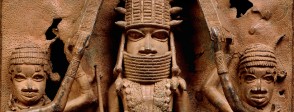The first five activities flow from one to the other or they could be done individually.
Working from the plaque without any other information, undertake an artefact enquiry. What do they think this is? What do they think it is made of? Who might have used it? How might it have been used – why does it have holes in the corners? Where might it have been found? What other questions do you want to ask about it? Follow up with the short video clip in For the classroom and discuss.
Look at the plaque in detail. Who do the students think is the most important person and why? What seems to be going on? Who are the other people? How are they dressed differently from the central figure and what does this imply about them? Then explain the features of the plaque so that they understand what it does show.
Use the link in About to object to the British Museum’s Collection online to select a number of plaques. Divide the class into groups and allocate each group one of the plaques to investigate for what it shows and what they learn about the court of the Oba and about life in Benin.
Choose this plaque and two or three from the British Museum’s Collection online. Pick out as many details as you can and write a simple card for each. Give groups of students the images of the plaques and ask them to match the cards. What sorts of things appear in most of the plaques? Are any of the plaques different from the others?
Use the objects in A bigger picture to link to the plaque. Ask the students to try to connect each object with the plaque in some way. If they cannot connect directly, can they think of an indirect connection? For any indirect connections, for example the stool, ask them to scan the other plaques on the British Museum website and see if they can find a direct connection.
Moving out from the plaque, there are numerous aspects of Benin that the students can explore.
How was Benin ruled? Start from the plaque and the head of the Queen Mother in For the classroom. Use these to initiate an enquiry into their civic, military and religious roles. Who else in Benin was powerful and what was their power based on?
Discuss the very limited elite of society to be seen in the plaques. What do we know of the way ordinary people lived and how do we know it? What ways did the people of Benin have for recording their own history?
Use a range of maps to locate Benin in relation to present-day Nigeria, to the rest of Africa, to Europe and to Britain. Get groups of students to find out who was ruling and what was happening in Britain, Portugal and other parts of Europe at the time when the plaques were made. Devise parallel timelines and record rulers, clothes, buildings, images, artefacts.
There is a coincidence of high civilisations in the 16th century. Carry out a worldwide comparative study: Benin, Elizabethan England, the Mughal Empire, Ming China, the Mexica (Aztec) Empire, the Ottoman Empire.
Why is it important to study Benin? What is significant about Benin? What does it contribute to understanding the history of Africa, Europe, the world and Benin today? What does the study of Benin add to our understanding of how to find out about the past?
What happened to Benin after the 16th century? What happened to Benin after the British attack in 1897? What is Benin like today? Is there still an Oba? What is his role?


